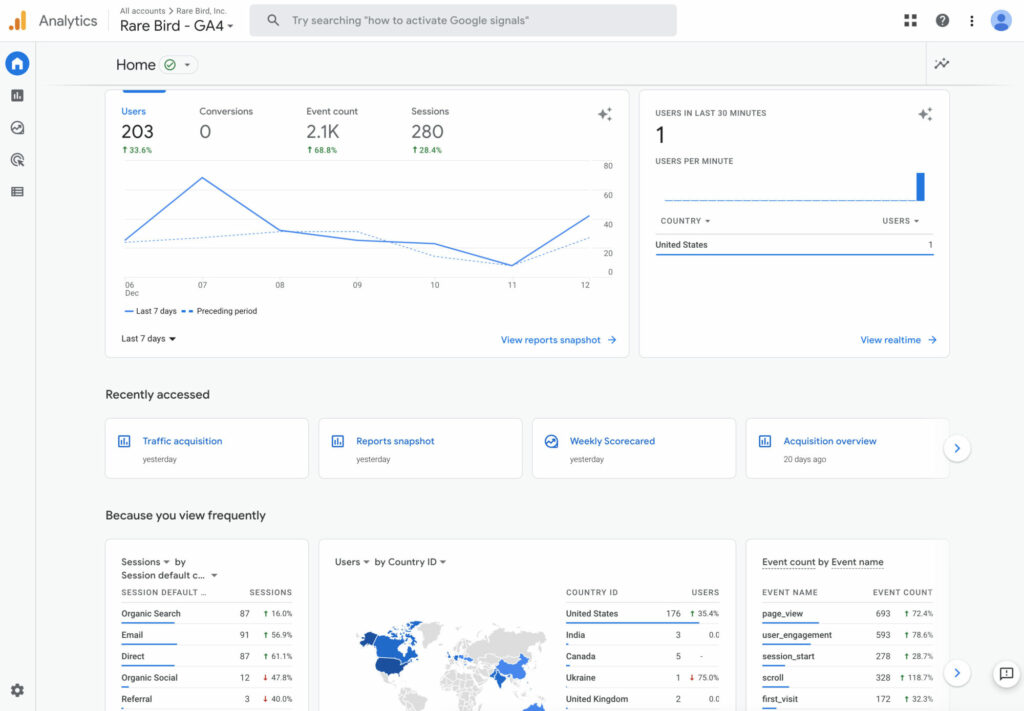Google Analytics, which has gone through many name changes and improvements since it was launched in 2005, helps identify which of your online marketing efforts have been successful, along with what elements of a website drive traffic, best connect with audiences, and increase the amount of time visitors spend on specific pages. With a tight focus on location- and demographic-specific information, GA allows marketers to better understand a customer’s journey to and through a website.
In summer 2023, some major changes—to put it mildly—are finalizing within the multi-year overhaul of Google Analytics. Businesses need to become aware of these evolutions so they can best adjust and accommodate for the coming changes. Actually, it’s even more important than that. If you want data about your website (you really, really do), you need to get onboard immediately.
Here are answers to some of the most commonly asked questions about Google Analytics and the GA4 iteration that our clients (and potential clients) should be familiar with before the switch officially finalizes next summer.
What Is Google Analytics and Why Is It Important?
Google Analytics is a free web analytics tool used to track and analyze the performance of websites and mobile apps.
What Is GA4?
Google Analytics 4—generally referred to as GA4 within the industry—is the fourth (and latest) version of Google Analytics that is scheduled to become the default version of the GA platform. Starting on July 1, 2023, only GA4 will actively collect data. This iteration of the service incorporates privacy features that more easily comply with most laws about data privacy.
What Does GA4 Replace?
Google Analytics 4 replaces Universal Analytics (GA3), which has been the default Google Analytics platform since 2012.
What Is Special About GA4?
GA4 features a completely redesigned interface and the addition of new metrics—engagement rate and average engagement time have replaced bounce rate and average session duration, for example.
Some of the most exciting updates involve the new custom report capabilities. With the custom report features built into GA4 and the recently rebranded Looker Studio, there are now more ways than ever to build a dashboard specific to your needs—or to dig into the nitty-gritty of what exactly is happening on your website.
More crucially, however, GA4 is not limited to tracking individual hits on a given website. It provides data related to how users behave over time, which makes it possible to more accurately track a customer’s lifecycle through your website. In other words, GA4 provides better data for users who make multiple visits. GA4 also combines data from websites and apps, which provides a more comprehensive understanding of what a site’s visitors are doing while also optimizing their privacy. These updates are just the tip of the iceberg with what’s new in GA4.


The GA4 interface (above left) provides more specifically tailored information we can use to better delineate the details of the customer journey.
When Will the GA4 Transition Occur?
Actually, it has already begun. We are deep within a long transitional period, with Google Analytics 4 and Universal Analytics currently overlapping. For the moment, each can actively track and collect website data. However, Universal Analytics will be “sunset” on July 1, 2023. After that date, UA will no longer receive or process any new data. Thus, it is essential to properly set up GA4 soon in order to begin collecting as much data as possible with the new account before the previous version shuts down. After July 1, 2023, users will only be able to view historical data from Universal Analytics for a period of six months. Google knows this can be a laborious process for some users, so we’ve been getting reminders within the platform for quite some time.

How Will GA4 Help My Business?
If your website plays an essential role in your business, then understanding how the website is working (or not working) is a crucial aspect of meeting your company’s goals. You want to know if a certain page or area of your site causes visitors to quickly leave your website, or if a recent email campaign that brought customers to your website kept them engaged after they arrived. Are mobile users frequently leaving the site after just a single page visit? These and other questions can only be answered with a web analytics platform like Google Analytics. Quickly identifying concerns that might negatively affect your business goals is critical in limiting potential losses. Likewise, the insight provided by knowing what areas are working can help answer future campaign questions.
Why Should My Business Care About GA4 Migration?
We strongly recommend creating a Google Analytics 4 account as soon as possible. Our team at Rare Bird has been working through our list of Universal Analytics accounts for clients and creating GA4 accounts for each of them. Doing so months in advance of UA’s sunset date allows for ample time to confirm the GA4 configuration before it becomes the sole source of website data available.
There’s even more to explore regarding the power of GA4 to revolutionize how a business learns from and improves based on analytics, but we don’t want to overwhelm you here. If your team has further questions or would like Rare Bird to help, please reach out to our team today.